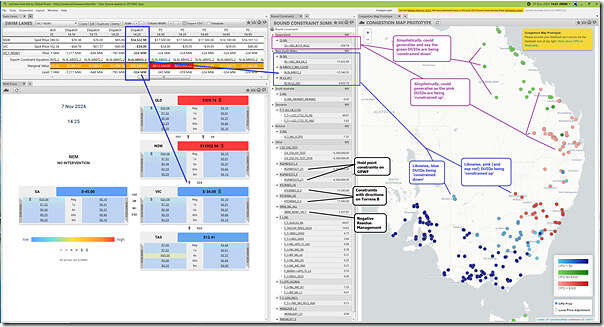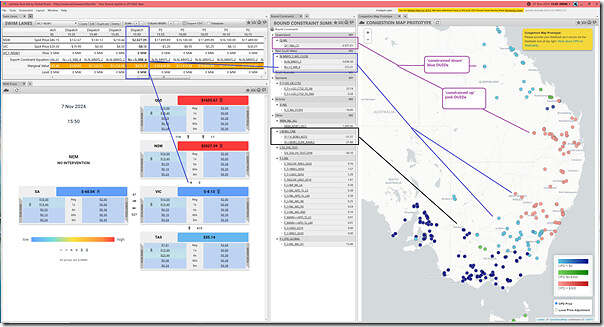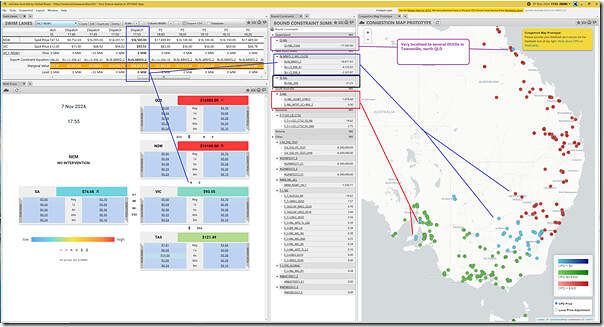With apologies in advance for this article, which will probably prompt more questions than it answers, we’ve selected three dispatch intervals through the long run of volatility in the QLD and NSW regions on Thursday 7th November 2024 to help illustrate:
1) How the issue of ‘congestion’ or ‘constraints’ in the NEM is so complex;
2) But also why it’s so significant to price and dispatch outcomes.
The intent is that we might start from here and then drill in further to these (and other) particular dispatch intervals (and Constraint Equations and Constraint Sets) … but those subsequent articles might take a while to complete. In the meantime those less knowledgeable readers might just take this as another illustration of how ‘The NEM’s a complex place™ … and increasingly so!’.
General notes:
1) All times are ‘NEM time’
2) All dispatch intervals illustrated with a collage of widgets from our ez2view software:
(a) The ‘Swim Lanes’ widget
(b) The ‘NEM Prices’ widget
(c) The ‘Bound Constraints’ widget
(d) Plus a prototype new widget we’ve been workshopping with clients in recent times:
i. which helps to tell the story…
ii. briefly, the dots are DUIDs coloured by each units CPD Price (which, you will clearly see, varies between DUIDs over an enormous range … due to congestion).
iii. Default colouring utilises the same default ‘Blue Green and Red’ colour scheme we’ve used for quite a while to categorise bids
… such as in the article ‘Updated trend of ‘ENERGY’ bids in red, green and blue’ from April 2024.
The 14:25 dispatch interval
We’ve selected this one, in part, because it was the one written up with ‘Price volatility starts early, on Thursday 7th November 2024’ early yesterday afternoon:
There’s plenty that could be pointed out in this single dispatch interval – some annotated on the image – but we’ll start with these highlights:
1) In Queensland we have one form of a ‘central-to-south’ style constraint equation bound:
(a) This is the ‘Q>>NIL_BCCP_RGLC’ constraint equation:
i. Which is a member of the ‘System Normal’ constraint set
ii. And is intended to ‘avoid overload of Raglan to Larcom Creek (8875) on trip of Bouldercombe to Calliope River (812) line’.
(b) Which acts to dissuade generation in the north and promote supply options in the south
… depending on how each unit bids, of course!
(c) More about this one later…
2) In NSW we have three separate constraint equations, each of which has a different purpose and effect, all combining to deliver a colourful map (and complex dispatch outcome):
(a) We have the ‘N>>NIL_964_84_S’ constraint equation
i. Which is a member of the ‘System Normal’ constraint set ; and
ii. Which is intended to ‘avoid overload of Port Macquarie to Herron Creek Tee (964/2) on trip of Tamworth to Liddell (84) line,’
ii. Affects units in northern NSW
(b) We have the ‘N::N_MNYS_2’ constraint equation
i. Which is a member of the ‘N-MNYS_5_WG_CLOSE’ constraint set
ii. Which is an outage-related constraint set in place because there is an ‘outage of the Marulan – Yass (5) 330kV line [with Wagga-Yass 132kV parallel lines CLOSED]’
iii. With the constraint equation bound above impacting on many units across southern NSW either side of the 330kV outage.
iv. Note that the ‘N::N_MNYS_2’ constraint equation is the only constraint equation (in this set) bound … at this point…
v. More about this one later…
(c) We also have the ‘N^N-LS_SVC’ constraint equation
i. Which impacts on the Directlink interconnector
ii. During times of ‘outage of Lismore SVC, or reactive power control mode’.
3) There are obviously other constraints that were bound in this dispatch interval … but the above were the main ones.
The 15:50 dispatch interval
The second dispatch interval we’re going to (semi-randomly) select is the 15:50 dispatch interval … because it was (as highlighted here) the next dispatch interval that saw prices above $1,000/MWh in QLD and NSW:
In this case, there are three bundles of constraint equations that we’d like to highlight:
1) In a Queensland ‘System Normal’ constraint set, we a different form of a ‘central-to-south’ style constraint equation bound:
(a) This one is the ‘Q^^NIL_CS’ constraint equation
(b) Which implements a ‘CQ-SQ voltage stability limit’ … ‘to prevent voltage collapse for a trip of a single Calvale-Halys line’
2) Of all the constraint equations in the ‘N-MNYS_5_WG_CLOSE’ constraint set (the outage-related constraint set noted above), in this dispatch interval there are two constraint equations bound:
(a) We have the ‘N::N_MNYS_2’ constraint equation bound … as it was at 14:25 above
(b) But we also have the ‘N>>5_998_4’ constraint equation bound:
i. This one is to ‘avoid overload on Cowra to Forbes (998) 132kV line on trip of Collector to Marulan (4) 330kV line, [Wagga-Yass 132kV parallel lines CLOSED]’
ii. There are also a large number of DUIDs on the LHS of this constraint equation.
3) Thirdly there are some constraint equations bound in the ‘I-BDBU_ONE’ constraint set:
(a) This constraint set is for ‘outage of Bundey to Buronga (6F) 330kV line, #5 Buronga phase-shifting transformer or #8 220/330kV transformer’
(b) And the two constraint equations bound are:
i. The ‘V^^V_BDBU_KGTS’ constraint equation is bound; and
ii. The ‘V>>BDBU_ELML_BAML2’ constraint equation is bound.
The 17:55 dispatch interval
The third interval we’re going to (semi-randomly) select is the 17:55 dispatch interval … because it was the one selected for the NEMwatch snapshot when reporting the ‘Late afternoon and Evening run of volatility in NSW and QLD, on Thursday 7th November 2024’:
In this dispatch interval we see some commonality, but also some differences…
1) In Queensland the two different types of broader divided (shown above) have unbound and instead there’s a hyper-localised ‘Q>NIL_TV66’ constraint equation that’s impacting a couple units in Townsville.
2) In NSW we see the ‘N-MNYS_5_WG_CLOSE’ constraint set once again … but on this occasion three constraint equations are bound:
(a) We again have the ‘N::N_MNYS_2’ constraint equation bound … as it was at 14:25 and 15:50 above
(b) We have the ‘N>>5_998_61’ constraint equation for the first time in this article:
i. Which is to ‘avoid overload of Cowra to Forbes (998) 132kV line on trip of Crookwell to Bannaby (61) 330kV line, [Wagga-Yass 132kV parallel lines CLOSED]’
ii. And has many DUIDs on the LHS
(c) We also have the ‘N>>5_998_4’ constraint equation bound … as it was at 15:50 above.
3) In NSW we also se the ‘N>NIL_999’ constraint equation bound
(a) This is a System Normal constraint equation
(b) Which is to ‘avoid overload of Bango999 to Cowra (999)’.
4) Also notable in South Australia there are two constraint equations bound in their own System Normal constraint set:
(a) We have the ‘S>NIL_HUWT_STBG3’ constraint equation bound
(b) We also have the ‘S-NIL_WTPT_SC+INV_2’ constraint equation bound
… but we’ll leave them along for now…
One of the main take-aways that readers might make in the above is that it was not just one constraint equation that was the single cause of all that went on in the price volatility on Thursday 7th November 2024 !





Be the first to comment on "Three dispatch intervals (sampled from a long run of volatility on Thursday 7th November 2024) to illustrate the complexity (and significance) of congestion"